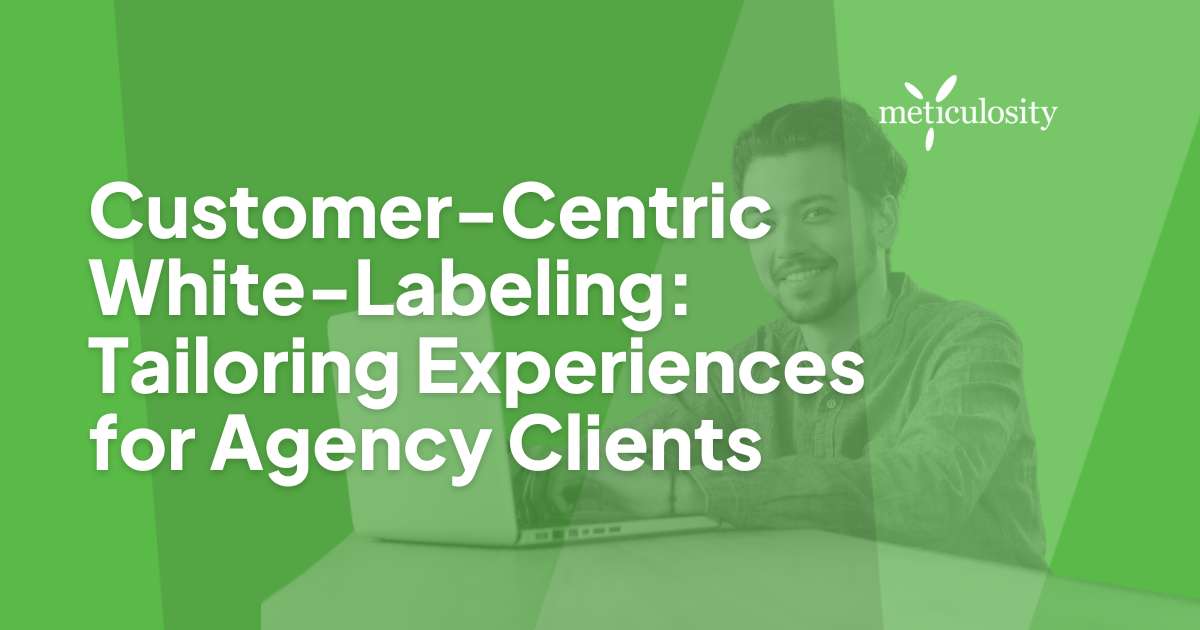Understanding each client's specific needs can feel like an uphill battle when your tools seem out of sync with their distinctive brand image.
Through exploring white-labeling solutions, we've gained insight into how tailoring these tools can be a game-changer for enhancing client contentment. Prepare to uncover tactics that will leave both you and your clients with a sense of satisfaction and partnership that truly shines.
Key Takeaways
- White-labeling lets agencies sell products with their brand, saving time and money.
- Being customer-centric means putting clients first for better loyalty and trust.
- Personalizing branding, communication, and services keeps clients happy and helps them stand out from others.
- Using the right white-label CRM helps agencies give clients what they need in a smooth way.
- Listening to client feedback is key to improving services and keeping strong relationships.
Understanding White-Labeling
White-labeling is the process of rebranding and customizing a product or service to be resold by another company. This approach allows agencies to offer their clients tailored experiences under their brand, providing a seamless and personalized customer journey.
Definition and Purpose
White-labeling means taking a product made by one company and branding it for another. It's like when a supermarket sells ketchup with its label on it, but another business makes the ketchup.
This way, companies can offer products without making them from scratch. The purpose is to save time and money while still giving customers what they want.
For agencies, being customer-centric with white-labeling is key. It means they focus hard on understanding their client's needs and make sure everything feels just right for those clients - from the look of things to how they work.
Next up, let's dig into why bringing that personal touch matters so much in white-labeling.
Importance of Customer-Centric Approach
Putting your clients at the heart of your business is key. A customer-centric approach means you always think about how to make things better for them. This way, they're more likely to stay with you and tell others about your great service.
When an agency focuses on their clients' needs, they can give them special attention and care. It makes sure that every decision helps the client succeed.
Being customer-centric also lets agencies be more flexible and ready to change as needed. You get to understand your clients deeply and offer solutions that fit just right for their challenges.
They'll see you as a partner who gets their business, not just someone selling a product or service. This builds trust and loyalty, which are super important for growing a strong relationship with each client.
Benefits of Personalizing Experiences for Agency Clients
Personalizing experiences for agency clients offers the opportunity to customize branding, communication, and services according to their specific needs and preferences. This tailored approach can lead to stronger client relationships, a competitive edge in the market, and increased customer satisfaction and loyalty.
Customizing Branding and Design
We understand how important it is to make every client feel special. That's why we focus on customizing branding and design for agency clients.
- Tailor the logo and color scheme to fit the client's brand identity. This makes their products or services instantly recognizable.
- Design a unique website layout that aligns with the client's business goals. A well-designed website can help them stand out online.
- Design marketing assets that match their brand's look and feel. Consistency across all platforms increases brand strength.
- Offer a selection of templates that can be tweaked to the client's preferences. This gives them control while saving time on design.
- Ensure all communications, such as emails and newsletters, carry the client's branding. It builds trust with their audience.
- Adjust user interfaces of apps or software to reflect the client's colors and logos. This supports a seamless brand experience for users.
- Provide branded reports that showcase data with the client's company image in mind. Clients appreciate this attention to detail.
Tailoring Communication and Support
After customizing branding and design, it's crucial to tailor communication and support to meet the specific needs of agency clients. Here are some essential ways in which this can be achieved:
- Personalized Communication: Creating tailored communication strategies based on the client's target audience and industry expertise.
- Dedicated Support Channels: Offering dedicated channels for client support, such as a personalized email address or direct phone line, to ensure quick and effective response times.
- Customized Reporting: Providing customized reports that align with the client's branding and contain the specific metrics they prioritize for their business.
- Client Education Materials: Developing educational resources and materials that cater to the unique needs of the agency's clients, helping them better understand products or services.
- Feedback Mechanisms: Implementing personalized feedback mechanisms to gather insights into each client's experience, allowing for continuous improvement in service delivery.
Offering Customized Services and Solutions
After tailoring communication and support, the next crucial step in customer-centric white-labeling is offering customized services and solutions. This ensures that agency clients receive tailored products or services that meet their needs and preferences. Here are the essential components to consider:
- Understanding Client Needs: Take the time to understand each client's unique requirements, goals, and pain points by engaging in open discussions and active listening.
- Customized Product Development: Develop personalized products or services to reflect each agency client's branding, messaging, and design elements.
- Flexible Service Options: Offer a range of flexible service options that can be adapted to fit the varying needs of different agency clients without compromising quality.
- Proactive Problem-Solving: Anticipate potential challenges or areas for improvement within each client's industry, then offer proactive solutions tailored to address these specific issues.
- Ongoing Consultation: Provide ongoing consultation and support to help clients navigate through any changes or challenges they may encounter while using the white-labeled products or services.
Looking to empower your agency? You can learn more here.
Benefits of Customer-Centric White-Labeling
By tailoring experiences for agency clients, businesses can strengthen client relationships, stand out from competitors, and increase customer satisfaction and loyalty. This approach allows for a more personalized and meaningful interaction with clients, ultimately leading to greater success and growth.
Strengthening Client Relationships
Strengthening client relationships is crucial for long-term success. By tailoring experiences to meet each agency client's specific needs and preferences, we can build trust and loyalty.
Customizing branding, communication, and support shows that we value our clients' individuality. This approach fosters a deeper connection, leading to more collaborative and fruitful partnerships.
Standing Out from Competitors
To stand out from competitors, it's crucial to focus on tailoring experiences and providing personalized solutions that address the specific needs of agency clients. We can effectively differentiate ourselves in the market by customizing branding, design, communication, and support for each client.
This customer-centric approach strengthens client relationships and enhances overall satisfaction and loyalty. Embracing a flexible and scalable white-labeling strategy allows us to offer unique services and solutions tailored to each client's business requirements, giving us a competitive edge in the industry.
By prioritizing customer-centric white-labeling and emphasizing collaboration as well as cost-effective outsourced solutions, we position ourselves as a forward-thinking partner that understands the individual needs of our clients.
Increasing Customer Satisfaction and Loyalty
To increase customer satisfaction and loyalty, focusing on personalized experiences is crucial. By tailoring branding, design, communication, and support for agency clients, you can strengthen your relationships with them.
This approach also helps your agency stand out from competitors and build trust with clients. Offering customized services and solutions ensures that clients feel valued and understood, leading to higher satisfaction and loyalty.
Implementing a customer-centric white-labeling strategy is essential in achieving these goals. Choosing the right white-label CRM, setting clear expectations and boundaries with clients, as well as integrating their feedback into the process are all key steps.

Implementing Customer-Centric White-Labeling
Choosing the right white-label CRM, setting expectations and boundaries, and integrating client feedback are essential steps in implementing customer-centric white-labeling. Ready to learn more about tailoring experiences for agency clients? Keep reading!
Choosing the Right White-Label CRM
To choose the right white-label CRM, it’s important to consider the scalability and flexibility it offers. Here are key factors to consider:
- Evaluate the CRM's customization options to ensure they align with your agency's branding and design needs.
- Look for a CRM that facilitates tailored communication and support features, enabling personalized client interactions at scale.
- Prioritize CRMs that allow for customized service offerings and adaptable solutions tailored to each client's unique requirements.
- Consider the integration capabilities of the CRM to seamlessly incorporate client feedback into the white-labeled services.
- Assess the CRM's user interface for ease of use and its ability to provide a seamless client experience.
Setting Expectations and Boundaries
In setting expectations and boundaries for customer-centric white-labeling, start by clearly defining the scope of customization that is offered to agency clients. This involves outlining the specific aspects of branding, communication channels, and service options that can be personalized.
By doing so, both parties have a mutual understanding of what is feasible within the white-labeling framework. Additionally, establishing clear boundaries ensures that there is no overextension of customizations beyond what was initially agreed upon.
This clarity helps in managing client expectations and prevents any misunderstandings down the line.
To choose an appropriate approach to setting expectations and boundaries for customer-centric white-labeling, it's important to involve clients in the process. This means actively soliciting their input on what they envision as personalized elements within their branded experience.
Integrating Client Feedback
After setting clear expectations and boundaries, integrating client feedback is crucial for successful customer-centric white-labeling. This ensures that their needs and preferences are continually considered and addressed. Here's how to effectively integrate client feedback:
- Conduct regular feedback sessions to gather insights on their experience with the white-labeled services.
- Analyze the feedback to identify areas for improvement and innovation in the personalized experiences offered to clients.
- Implement actionable suggestions and requests from clients, demonstrating a commitment to meeting their specific needs.
- Communicate changes made based on client feedback, showing that their opinions are valued and taken seriously.
- Continuously iterate based on ongoing client input, fostering a collaborative approach that enhances the value of the white-labeled services provided.

Conclusion
In conclusion, customer-centric white-labeling is essential for agency clients. Tailoring experiences can strengthen client relationships and set businesses apart from competitors.
By implementing a personalized approach, companies can increase satisfaction and loyalty while delivering customized solutions to meet client needs effectively. This proactive strategy will be beneficial for marketers and business professionals looking to enhance their services in a competitive market.
Click here to learn more about agency marketing.
FAQs
1. How does customer-centric white-labeling differ from traditional white-labeling, and how does it prioritize the client's experience?
-
- Focus on Client Experience: Customer-centric white-labeling prioritizes the client's experience, ensuring that solutions are tailored to meet their specific needs and expectations.
- Personalization: It involves a more personalized approach, considering each client's unique preferences and goals.
2. Can you provide examples of how agencies have successfully implemented customer-centric white-labeling to enhance the client experience and satisfaction?
-
- Tailored Solutions: Agencies share instances where they tailored white-label solutions to address specific client challenges, leading to increased satisfaction.
- Positive Client Feedback: Examples of positive client feedback and testimonials resulting from the implementation of customer-centric white-labeling.
3. In what ways can customer-centric white-labeling contribute to building long-term relationships with clients and fostering loyalty and trust?
-
- Client-Centric Solutions: Customer-centric white-labeling builds trust and fosters long-term relationships by providing solutions that align closely with client needs.
- Adaptability: The adaptability of white-label services to client preferences contributes to client loyalty, as clients feel their needs are consistently understood and addressed.
4. How can agencies seamlessly integrate customer-centric white-labeling into their overall service delivery, creating a cohesive and unified client experience?
-
- Collaborative Planning: Collaborate closely with clients during the planning phase to understand their objectives and expectations.
- Clear Communication: Ensure clear and transparent communication with clients throughout the implementation of white-label solutions, keeping them informed at every stage.
- Feedback Mechanisms: Establish feedback mechanisms to continuously assess and improve the client experience, making adjustments based on real-time insights.
Customer-centric white-labeling goes beyond traditional approaches by prioritizing the client experience, tailoring solutions, and contributing to building long-term relationships based on trust and satisfaction.








